The Least To Most Painful Types of Ear Piercings, Ranked
The Least To Most Painful Types of Ear Piercings, Ranked
If you find yourself endlessly scrolling through ear-piercing inspiration photos, you’re not alone. Multiple ear piercings have become one of the trendsetters’ most beloved accessories and allow you to express your creativity through unique placements or custom combinations. Every “curated ear” is different to reflect the wearer’s personal style. Ear piercings are the perfect accessory to dress up your work-from-home look for daily Zoom calls or virtual meetings, even if you’re wearing them with sweatpants underneath.
Unlike some wearable art forms like tattoos (or semi-permanent makeup), ear piercings require less commitment and can be added or removed over time. Ear piercings take some time to heal. However, you have the option to keep the holes for years or temporarily.
Whether you’re an ear-piercing veteran on the hunt for the next best placement, finally looking to get your lobes pierced or a cartilage piercing, pain is always a consideration – even if it’s not at the forefront of our minds. Ultimately, everyone’s pain tolerance is subjective, and no two experiences will be the same. However, if you’re still deciding on a new placement or mentally preparing yourself for a piercing session, we’ve put together some general guidelines on the pain levels to expect with each type of ear piercing.
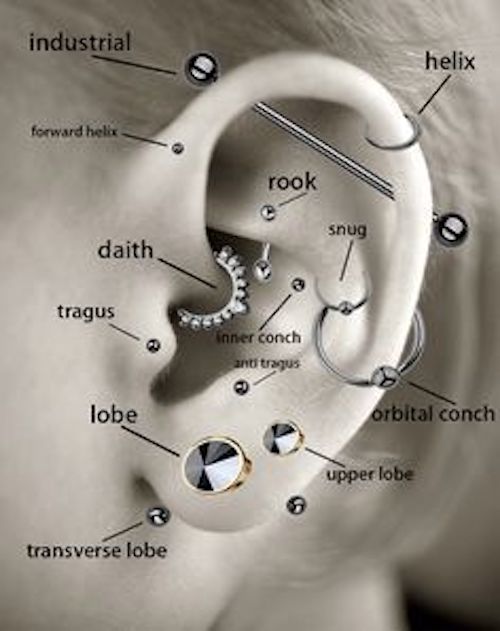
Credit: Fresh Trends/Pinterest
Read on to discover where different ear piercing types rank on the pain scale, from the least to the most painful (with healing times included).
Least Painful:

Credit: @letsearparty/Instagram
Standard Lobe Piercing
A standard lobe piercing is most individuals’ first piercing. Many people get this lobe piercing as a child or many years before they plan more placements. Therefore, it should not be surprising that it ranks low on the pain scale – the general rating seems to be 3/10. A standard lobe piercing can hurt for a moment or just feel like a pinch when the needle goes through. Often, the most uncomfortable part of the experience is an aching pressure right after the hole is made.
If you don’t already have any ear piercings, a standard lobe placement is the most approachable and convenient option. They typically only take 1-2 months to heal. Always get your ear lobes pierced with a needle instead of a gun. A needle will cause less trauma to the area and is a more hygienic option. Double lobe piercings are a great option for individuals who already have their single lobe holes and want to ease their way into getting another piercing. The second hole on the lower lobe should have the same pain level and healing time as the first one.
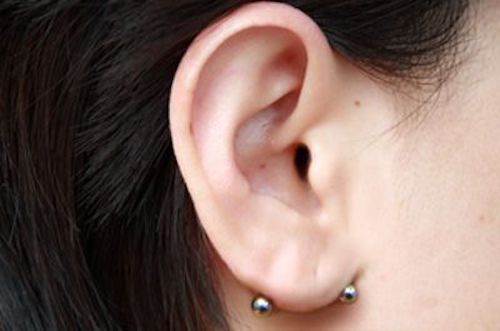
Credit: BodyCandy Body Jewelry/Pinterest
Transverse Lobe Piercing
Unlike a traditional lobe piercing, a transverse lobe piercing goes horizontally through the lobe instead of front to back. This piercing often uses a barbell and sticks out on either side of the ear. Your ear shape will determine how the transverse lobe piercing is done and how the results look. If you have attached earlobes, the piercer will likely use a curved needle (so they don’t puncture your face), and the final piercing will also appear curved. If you have detached earlobes, the piercer will use a straight needle, and the piercing will look straight once completed.
On the pain scale, this piercing typically feels like around a 4/10. Because this is still a piercing on the lobe, many people will find the pain level will be considerably lower with this piercing than a cartilage piercing. A transverse lobe piercing takes at least 2 months to fully heal, but it could take up to 10 months, depending on how your skin recovers.
Mildly To Moderately Painful
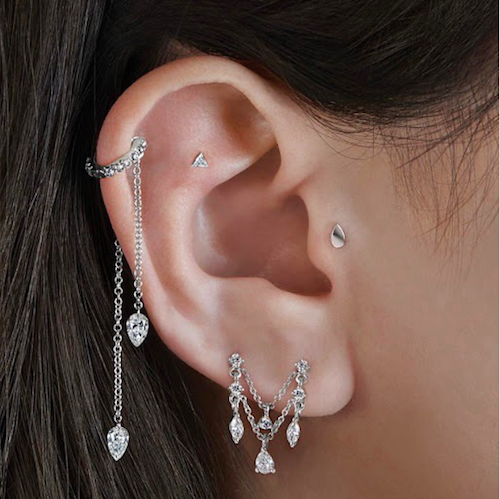
Credit: @mariatash/Instagram
Helix Piercing
A helix piercing is a cartilage placement on the outer upper rim of your ear. Because the cartilage is thinner on the upper ear, helix piercings tend to be the least painful cartilage piercing. They measure around a 4-5/10 on the pain scale and take around 3-6 months to fully heal. Keep in mind, though, if you decide to get multiple helix placements (a double or triple helix), one or more of these piercings can be more painful than the others, depending on your ear shape and the amount of cartilage you’re piercing.
Forward Helix Piercing
The forward helix is a cartilage piercing placed on the outer upper ear, directly above the tragus and opposite the hairline. Like the traditional helix, you can eventually get multiple piercings in this area and rock a double or triple helix look. When it comes to the pain level, a forward helix piercing would rate at a 5-6/10 on the pain scale. The healing time for this piercing is around 3-9 months. While the wound recovery process may take some time, this piercing tends to be fairly low maintenance once it fully heals.
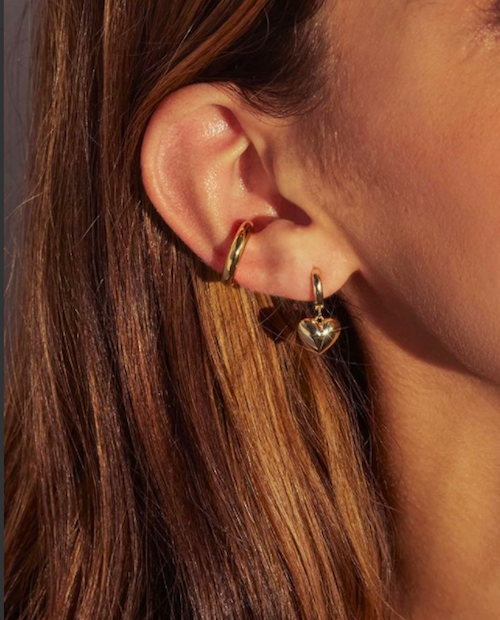
Credit: @analuisany/Instagram
Orbital Piercing
An orbital piercing includes two holes connected by a hoop. This piercing is made either on the ear lobe or the lower portion of the outer ear (helix). An orbital piercing is similar to an industrial placement with a significantly lower pain level and shorter healing window. Depending on the placement of your orbital piercing, it should measure somewhere between a 4-5/10 on the pain scale and heal within 2-3 months.
Tragus Piercing
Placed on the cartilage over the ear canal, the tragus is a popular ear piercing among trendsetting celebrities and is a stylish addition to a curated ear. A tragus piercing falls relatively low on the pain scale and is generally rated around a 4/10 – similar to a helix placement. During the healing process, keeping the tragus clean can be a bit tricky. While your tragus piercing is recovering, you need to be careful when speaking on the phone or using earphones and earbuds. These devices can irritate the area and lead to infection if not treated properly. Avoid putting any of these objects near or in your ears for the first few weeks after getting your piercing. Overall, the healing time for a tragus piercing is between 6-12 months.
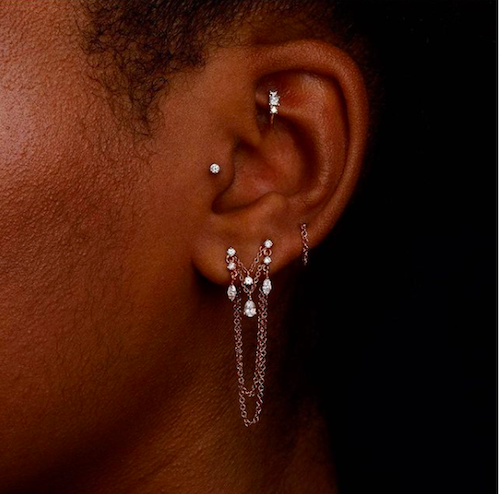
Credit: @letsearparty/Instagram
Moderately Painful:

Credit: @mariatash/Instagram
Daith Piercing
The daith piercing surrounds the innermost fold of cartilage in the ear and is known for its potential health benefits. Its name is rooted in Jewish culture, translating into “knowledge” or “knowing” in English. Anecdotal evidence suggests that Daith piercings can ease the pain for individuals suffering from chronic migraines. While scientific research has yet to support this claim, the Daith piercing sits on an acupressure point, which could be why this placement provides many individuals with relief.
When it comes to pain, the Daith piercing likely will hurt a little more than a helix or lobe piercing. The cartilage is thicker in this area, which means there will be more resistance when this skin is pierced. Expect a dull pain that measures around a 5/10 on the pain scale. It should take around 6-9 months for the piercing to fully heal. However, unlike a cartilage piercing on the outer ear, you can sleep on the side with the Daith piercing after a couple of months into the healing process.
Conch Piercing
A conch piercing is a cartilage piercing next to the curvature of the ear. Depending on your ear shape, you might choose to get an inner or outer conch piercing. An inner conch p iercing is located on the flat cartilage inside your ear and is styled with a stud. The outer conch piercing sits right next to the ear’s curvature (between the helix and anti-helix) and often is adorned with a hoop earring. The conch piercing provides the most space for different types of earrings and styling options because of the area it’s placed in. This versatility makes it one of the most desirable placements, especially for individuals seeking the perfect curated ear.
The pain level will be a little higher than the placements previously mentioned, due to the shape and thickness of the cartilage in this portion of the ear. An inner or outer conch piercing is generally considered a 6/10 on the pain scale. The healing process takes approximately 3-9 months and should not be slept on until the piercing is fully healed.
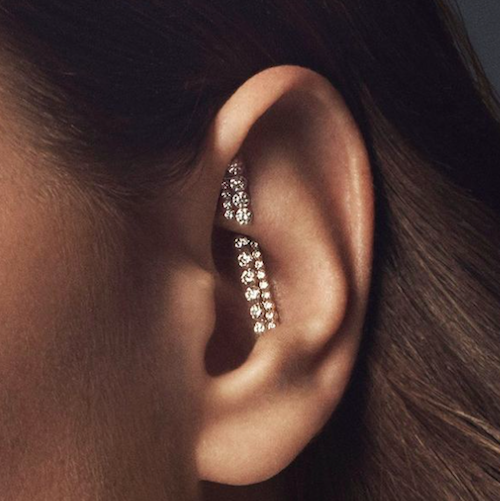
Credit: @mariatash/Instagram
Anti-Tragus Piercing
The anti-tragus piercing is located on the small, curved area of cartilage between your ear lobe and tragus. On the pain scale, the anti-tragus ranks at a 6-7/10 and, while attractive, is one of the most sensitive placements you can get. This piercing takes around 6-12 months to fully heal. You should not sleep on this ear and not use earphones, headphones or earbuds for at least 6 months after getting this piercing. The area will likely be sensitive for up to a year after the hole is created.
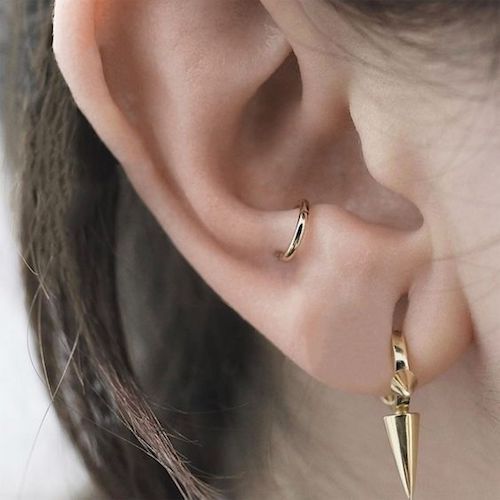
Credit: Glamour UK/Pinterest
Flat Piercing
As its name suggests, the flat piercing is a cartilage piercing located on the flat area below the ear’s upper outer rim. While you should get one at a time, multiple flat piercings allow you to lean into the ear constellation trend and create your unique version. These piercings require a stud or flat-back earring. The pain level might be higher due to the thicker cartilage in the area. On the pain scale, a flat piercing would generally fall at a 6-7/10. These placements can take anywhere from 3-10 months to fully heal.
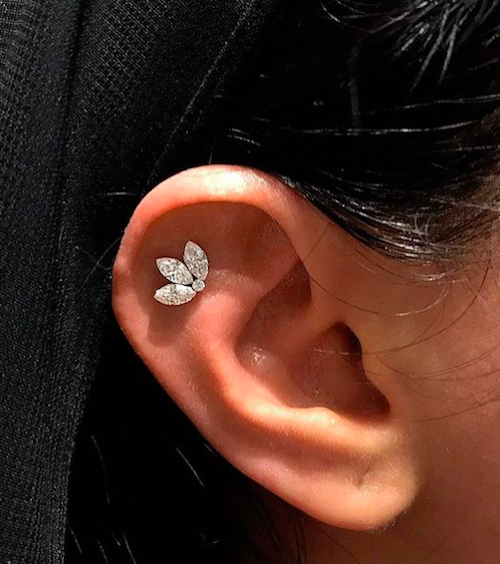
Credit: @mariatash/Instagram
Most Painful:
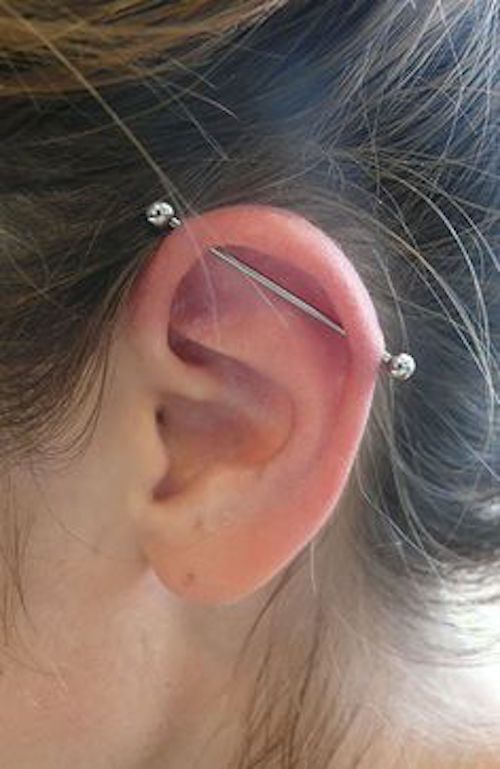
Credit: TheTrendSpotter/Pinterest
Industrial Piercing
A traditional industrial piercing refers to two cartilage piercings on the upper ear connected with a barbell. This placement is not for the weak. It has a fairly high pain level – considering the thickness of the cartilage and the pain of getting two piercings done in the area at once. On the pain scale, the industrial piercing ranks at around a 7/10. It should take between 4-6 months for these holes to fully heal, but the healing process could take up to a year.
It is important to note, though, that an industrial piercing can be any two holes on the ear connected with a barbell. Industrial piercings are dependent on your ear shape, so consult with a professional to see if the traditional placement or another option is right for you.
Rook Piercing
The rook piercing is placed on the upper ridge of cartilage on the inner ear. This piercing is a less popular alternative to a Daith or tragus placement and can set your curated ear apart from the masses. In terms of pain, the rook piercing requires a hole to go through a considerably thick layer of cartilage – meaning it is not going to be the most pleasant few seconds. It tends to rank between a 6-8 on the pain scale.
However, some individuals find the rook piercing to be less painful than a Daith or tragus piercing, so it truly depends on your anatomy. It takes approximately 6-12 months for a rook piercing to fully heal.
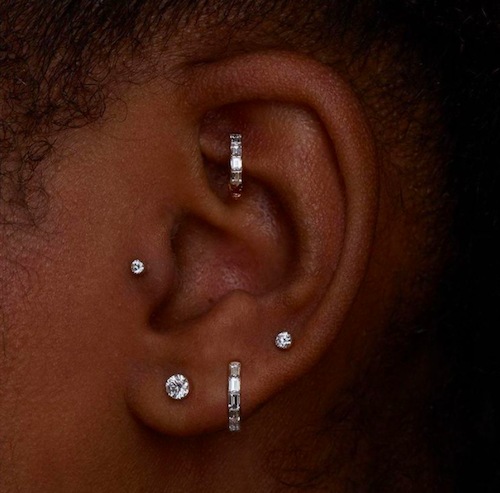
Credit: @mariatash/Instagram
Snug Piercing
Also known as the anti-tragus, the snug piercing is a cartilage piercing where your inner conch piercing would be located and the outer ridge of your ear. Whether you’re eligible for this piercing will depend on your ear shape. The snug piercing is known to be the most painful ear piercing for the majority of people to receive.
On the pain scale, it ranks at around a 9/10 compared to other piercings. However, keep in mind that even the most painful piercings will likely hurt less than getting a paper cut. Snug piercings typically take between 4-6 months to heal, but they can take up to 12 months before they fully heal.
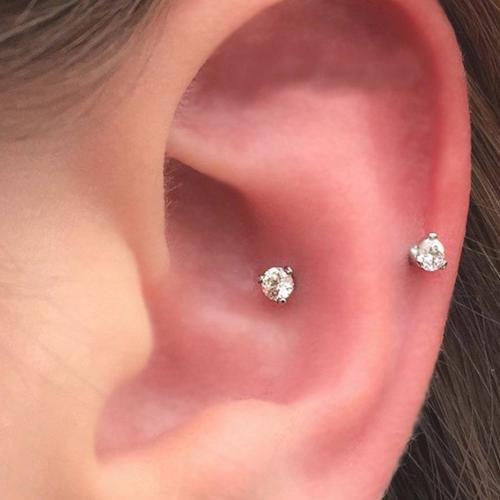
Credit: MyBodiArt/Pinterest
How To Minimize Ear Piercing Pain
Finding the right piercer is essential to minimize piercing pain during the appointment and prevent infection (or other issues) in the coming weeks that cause discomfort. Do your research and make sure to find a knowledgeable piercer. While always important, it is particularly crucial when you’re looking to get a more intricate cartilage piercing and placements where your ears’ anatomy plays a role in your eligibility for a certain piercing or how it gets done.
Staying calm is key in the time leading up to and during your piercing session. Make sure that you have something to eat and drink before your appointment. Plan some distraction techniques ahead of time if you get nervous in the moment. For some extra protection against potential pain, ask your piercer if using a topical numbing cream would be right for you. If given the green light, apply Zensa Numbing Cream 30-45 minutes before your piercing appointment for best results. Applying ice to the area after your piercing can be helpful for some individuals, too.
Best Ear Piercing After-care Practices
Wash the area twice daily with a recommended saline solution or gentle soap and water. Dry it with paper towels to ensure bacteria or other germs don’t infect the area. Avoid going in public pools or bodies of water that could infect the healing wounds. Don’t touch the piercing unless you’re cleaning it, and make sure to wash your hands beforehand. Keep your bedding clean, and do not use your regular towels on the pierced area. Following a healthy diet and lifestyle can also aid in the wound healing process.
It is generally recommended not to remove the initial jewelry from the piercing for at least 6-8 weeks after your appointment. Always carefully listen and follow your expert’s specific instructions for your particular piercing.
If you’re interested in getting a new placement, here’s a guide to 12 ear piercing types to consider.
